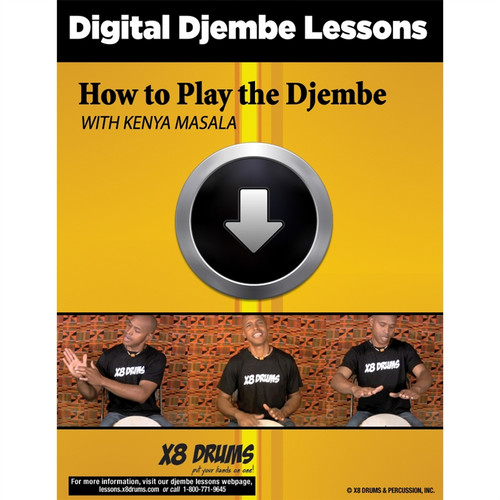How to Play the Djembe
It's important to understand the fundamentals of playing the djembe when you're first beginning. In fact even if you've been playing for years, it never hurts to go back to reviewing the basics. Too many times players have jumped into playing their instrument without properly understanding correct body positioning and playing technique. And when it comes to playing hand drums this can surely lead to sore hands and painful joints.
Playing Positions
I would venture to say that the sitting position is probably the most common position when playing the djembe. In this position, it's important to make sure you are using the right size djembe for your height. Sit on the front edge of a chair and place the djembe drum between your legs gripping each side with your knees. Tilt the djembe away from you so that the base of the drum is open. This is important as the bottom hole must be exposed in order to obtain a proper sound when playing. Some players will choose to hold the base of the drum with their feet for overall instrument control. Please remember not to lift the drum completely off the floor. If the drum is lifted off the floor when striking the head, it could slip and the base could hit the floor causing damage to your djembe.
It's vital that you keep correct posture when playing. Remember to keep your back straight so as to keep from slouching. Correct posture will ensure a longer playing time without the aches and pains associated with improper playing technique.
Basic Playing Strokes
The bass stroke is played with a hand at the center of the drum. The right hand bass note is called 'GUN', and the left is called 'DUN'. Essentially your goal is to bounce your whole hand off the skin without too much slapping sound. When struck correctly the tone will resonate out from the bottom of your drum. Take note that you don't have to hit the skin very hard. Your entire hand should be inside the rim of the drum, and should have a degree of firmness to it - not so firm that your hand is rigid, however not to loose either. Practice a few times so you can figure out what works for you. Remember, only one hand should be on the skin at a time.
Next is what's called as "edge tones". Edge tones are played at the edge of the drum where your hands are lined up at the rim of the djembe closest towards your body. Move your hands towards you until your knuckles have just come off the drum. The remaining pads of your fingers should be held over the drumhead. Striking the drumhead at the edge with the pads of your fingers will produce a type of ringing tone. The right hand stroke is called 'GO', and the left hand stroke is called 'DO'. You can play these tones by making your finger pads hit the skin very evenly or by striking the skin on more of an angle.
 Perfect djembe instruction guide for anyone wanting to join a drum circle or to review the basics.
Perfect djembe instruction guide for anyone wanting to join a drum circle or to review the basics.
Lastly, there are the "slap tones". The slap tones have characteristics of both the bass and edge tones. The slap tones produce more of a 'crack' and bright sound, however they also have a little bass resonance. The slap tones are played near the edge of the drum, with your knuckle line over the rim of the djembe falling onto the playing surface. Relax your hand so that there is a little pocket of space between the drumhead and your hand. From here your fingertips should almost reach the middle of the drum and your palms should fall over the rim of the djembe. Your hand should bounce off the drumhead so that the fingertip pads flick quite sharply on and off the surface with a slap. The pocket of space under the palm gives the tone a hollow sound, and the flicking action produces a sharp sounding tone. As with the bass tones the reach of the fingertips towards the center of the djembe provide the lower tones. The right hand stroke is called 'PA', and the left hand stroke is called 'TA'.
Learning to play the djembe takes time, dedication, and a personal commitment of continuing at it until you get it right. Just like learning to play any other instrument practice is the main ingredient and perseverance is at the heart of improving your skills. But above all else remember to have fun and enjoy the process. After all, you're making music - what a treat!
Djembe Buying Guide
2. Djembe Wood Source & Lathing [Video]
3. Djembe Shell Carving & Painting [Video]
5. Which Size Djembe is Right for Me? [Video]
6. Key Tuned vs. Rope Tuned Djembe
7. Djembe Drum: Wood vs. Synthetic
8. How to Tune a Djembe [Video]
9. Earth Friendly Djembe
10. A Note About African Djembes
11. Djembe Rhythm Samples and Exercises [Video]
12. Djembe Rope. Why Quality Matters.
13. Taking Care of your Djembe
15. How to Play the Djembe [Video]
16. Play the Djembe is Easy for All!
Recent Posts
-
X8 Drums Play-Along Backing Tracks
The new X8 Play-Along Series is being produced for our musician friends wanting a fresh way to work …9th Feb 2025 -
What is the Best Size Djembe for Beginners?
If you're new to the world of percussion and interested in learning the djembe, you're in for a t …16th Jul 2024 -
The Benefits of Becoming a Drumming Teacher: Transforming Passion into Profession
Why become a drumming teacher? Becoming a drumming teacher is an excellent way to share your pas …22nd May 2024



